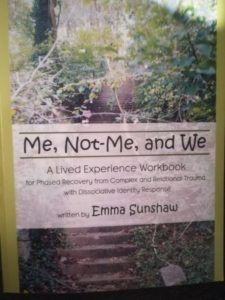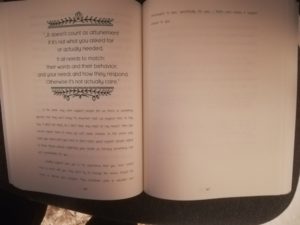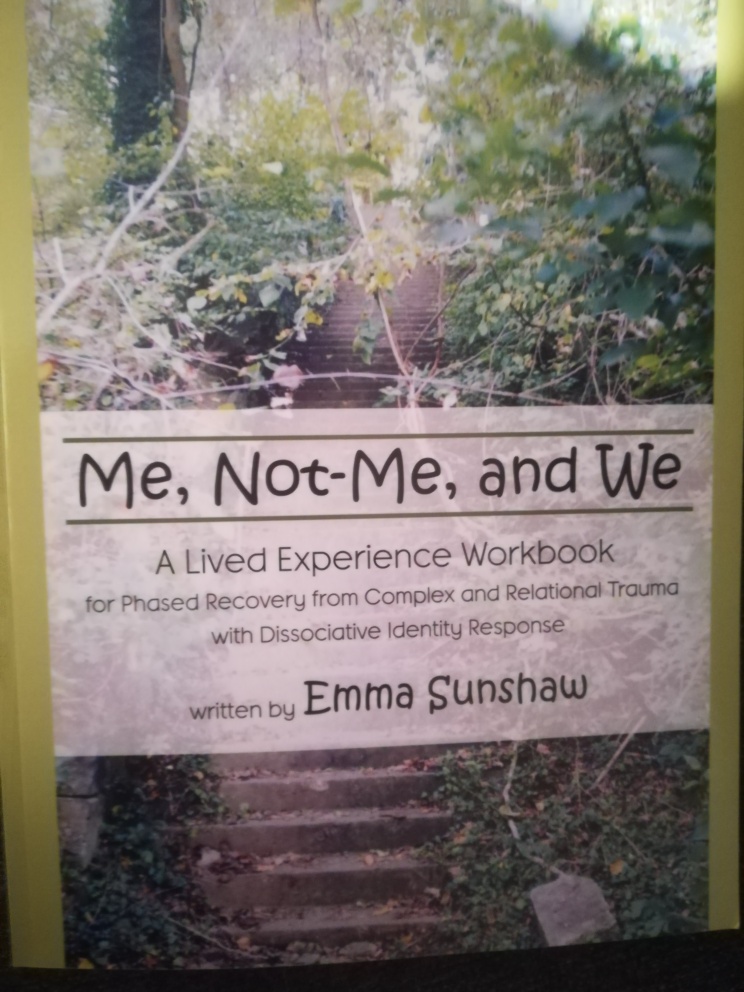Me, Not-Me, and We: A lived experience workbook for phased recovery from complex and relational trauma with dissociative identity response by Emma Sunshaw
Written by: A member of the ISSTD who found out about their DID later in life, so this is a mix of up-to-date professional information and lived experience
Written for: people with DID, especially those at the very beginning of recovery
Special focus: Basic information and exercises for the stabilization phase
What it is not:
- an in-depth workbook
- sharing a lot of personal experience
- for people who know their basics
- as big as it looks
- for people with severe symptoms
- speaking about programmed DID
Language: Sentences are usually short with very simple words. It sometimes feels like she is talking to children, which might be helpful because younger parts feel like they are included. It can also make parts feel patronized. The book is not translated into other languages but with basic english skills you could understand it.
Book: It looks like a 450 page book (and is priced like one) but the font size is really big and it has double line spacing. There are also quotes from the text printed in a huge size and lots of empty pages. What looked like something bigger than Coping with trauma-related dissociation is actually far smaller when we look at the word count. This could have been printed on 200 pages. The whole book is written in an unusual font to make it look more like handwriting, which makes it hard to read.

Overview:
The book explains relational trauma and the damage caused by misattunement and how to find help for that. It addresses basics like safety, grounding, coping skills, self-care and support people. Basic exercises like the Safe Place and Containment are introduced. There are ideas for journaling, mapping, team meetings and how to start communication between parts. Personal boundaries in relationships online and offline are explained. Grief is included as important work that happens during recovery.
At the end of every chapter there are practical exercises in four categories: journaling questions, mindful movement, creative and relational. These exercises are specific to this book and most of them are not found in the general literature.
After reading:
The first thing I noticed are the excellent content notes at the beginning of every chapter. They summarize the content and prepare you well for what you are about to read. The text is held as free of triggers as it is humanly possible.
The best thing about this book are the metaphors. Almost every chapter introduces a picture or little story to explain a situation and these metaphors help to understand what is going on and how to make sense of the things we experience. This book is worth reading for the metaphors alone.
I would not buy it for the explanations of the basic exercises because they are short and very limited. The exercises at the end of the chapters are easier to follow. I noticed that there is a LOT of dancing suggested in this book. Generally, it feels girly and sweet and people who don’t identify as very feminin could feel put off.
The language bothered me as a part because I felt patronized and like the author doesn’t believe I can do this or tries to protect me from having a hard experience. Our other host read the same things as caring and gentle, so I guess it will be a matter of personal style if you like it or not.
The font and spacing is an intentional choice that is explained. It is supposed to help with pacing. I don’t want to criticize it too much because it does just that, and very effectively. Between every other chapter there is also a page with an extra exercise or a picture you can color and that is cleverly done pacing as well. Just be aware of it if you buy it to avoid frustration.
For some reason I don’t understand, some content was moved to the back of the book. The lists of grounding skills or other advice are so disappointingly short that they could have fit into the main chapter without problems.
After a personal correspondence with the author I am a bit confused about the inclusion of plural resources. It is my personal opinion but I would recommend that beginners stay far away from plural resources to avoid utter confusion. They tend to be anti-recovery and spread misinformation about concepts of structural dissociation and treatment.
I have to admit that I expected a lot from this book and after reading it I feel underwhelmed. It is written for beginners. Except for some of the metaphors there was nothing in it that I haven’t seen explained better in other places. Things are kept very shallow. People who seek comfort and understanding and gentle words for the beginning of their scary journey might find great support. It isn’t the best book for brain-heavy people, like me. I would not buy this book again but I will keep it in my library to reference the metaphors.


Leave a Reply